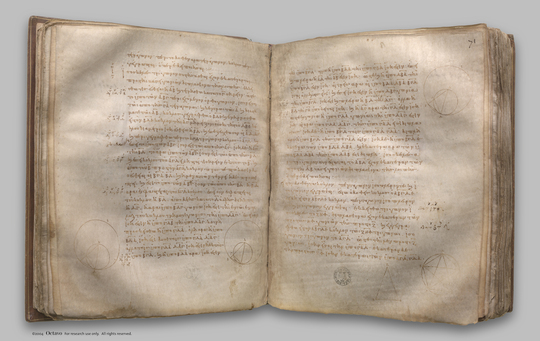index prev next | digilib folio 75

In a given circle to inscribe an equilateral and equiangular pentagon.
| Εἰς τὸν δοθέντα κύκλον πεντάγωνον ἰσόπλευρόν τε καὶ ἰσογώνιον ἐγγράψαι. Ἔστω ὁ δοθεὶς κύκλος ὁ ΑΒΓΔΕ: δεῖ δὴ εἰς τὸν ΑΒΓΔΕ κύκλον πεντάγωνον ἰσόπλευρόν τε καὶ ἰσογώνιον ἐγγράψαι. Ἐκκείσθω τρίγωνον ἰσοσκελὲς τὸ ΖΗΘ διπλασίονα ἔχον ἑκατέραν τῶν πρὸς τοῖς Η, Θ γωνιῶν τῆς πρὸς τῷ Ζ, καὶ ἐγγεγράφθω εἰς τὸν ΑΒΓΔΕ κύκλον τῷ ΖΗΘ τριγώνῳ ἰσογώνιον τρίγωνον τὸ ΑΓΔ, ὥστε τῇ μὲν πρὸς τῷ Ζ γωνίᾳ ἴσην εἶναι τὴν ὑπὸ ΓΑΔ, ἑκατέραν δὲ τῶν πρὸς τοῖς Η, Θ ἴσην ἑκατέρᾳ τῶν ὑπὸ ΑΓΔ, ΓΔΑ: καὶ ἑκατέρα ἄρα τῶν ὑπὸ ΑΓΔ, ΓΔΑ τῆς ὑπὸ ΓΑΔ ἐστι διπλῆ. τετμήσθω δὴ ἑκατέρα τῶν ὑπὸ ΑΓΔ, ΓΔΑ δίχα ὑπὸ ἑκατέρας τῶν ΓΕ, ΔΒ εὐθειῶν, καὶ ἐπεζεύχθωσαν αἱ ΑΒ, ΒΓ, [ ΓΔ ], ΔΕ, ΕΑ. Ἐπεὶ οὖν ἑκατέρα τῶν ὑπὸ ΑΓΔ, ΓΔΑ γωνιῶν διπλασίων ἐστὶ τῆς ὑπὸ ΓΑΔ, καὶ τετμημέναι εἰσὶ δίχα ὑπὸ τῶν ΓΕ, ΔΒ εὐθειῶν, αἱ πέντε ἄρα γωνίαι αἱ ὑπὸ ΔΑΓ, ΑΓΕ, ΕΓΔ, ΓΔΒ, ΒΔΑ ἴσαι ἀλλήλαις εἰσίν. αἱ δὲ ἴσαι γωνίαι ἐπὶ ἴσων περιφερειῶν βεβήκασιν: αἱ πέντε ἄρα περιφέρειαι αἱ ΑΒ, ΒΓ, ΓΔ, ΔΕ, ΕΑ ἴσαι ἀλλήλαις εἰσίν. ὑπὸ δὲ τὰς ἴσας περιφερείας ἴσαι εὐθεῖαι ὑποτείνουσιν: αἱ πέντε ἄρα εὐθεῖαι αἱ ΑΒ, ΒΓ, ΓΔ, ΔΕ, ΕΑ ἴσαι ἀλλήλαις εἰσίν: ἰσόπλευρον ἄρα ἐστὶ τὸ ΑΒΓΔΕ πεντάγωνον. λέγω δή, ὅτι καὶ ἰσογώνιον. ἐπεὶ γὰρ ἡ ΑΒ περιφέρεια τῇ ΔΕ περιφερείᾳ ἐστὶν ἴση, κοινὴ προσκείσθω ἡ ΒΓΔ: ὅλη ἄρα ἡ ΑΒΓΔ περιφέρεια ὅλῃ τῇ ΕΔΓΒ περιφερείᾳ ἐστὶν ἴση. καὶ βέβηκεν ἐπὶ μὲν τῆς ΑΒΓΔ περιφερείας γωνία ἡ ὑπὸ ΑΕΔ, ἐπὶ δὲ τῆς ΕΔΓΒ περιφερείας γωνία ἡ ὑπὸ ΒΑΕ: καὶ ἡ ὑπὸ ΒΑΕ ἄρα γωνία τῇ ὑπὸ ΑΕΔ ἐστιν ἴση. διὰ τὰ αὐτὰ δὴ καὶ ἑκάστη τῶν ὑπὸ ΑΒΓ, ΒΓΔ, ΓΔΕ γωνιῶν ἑκατέρᾳ τῶν ὑπὸ ΒΑΕ, ΑΕΔ ἐστιν ἴση: ἰσογώνιον ἄρα ἐστὶ τὸ ΑΒΓΔΕ πεντάγωνον. ἐδείχθη δὲ καὶ ἰσόπλευρον. Εἰς ἄρα τὸν δοθέντα κύκλον πεντάγωνον ἰσόπλευρόν τε καὶ ἰσογώνιον ἐγγέγραπται: ὅπερ ἔδει ποιῆσαι. | In a given circle to inscribe an equilateral and equiangular pentagon. Let ABCDE be the given circle; thus it is required to inscribe in the circle ABCDE an equilateral and equiangular pentagon. Let the isosceles triangle FGH be set out having each of the angles at G, H double of the angle at F; [IV. 10] let there be inscribed in the circle ABCDE the triangle ACD equiangular with the triangle FGH, so that the angle CAD is equal to the angle at F and the angles at G, H respectively equal to the angles ACD, CDA; [IV. 2] therefore each of the angles ACD, CDA is also double of the angle CAD. Now let the angles ACD, CDA be bisected respectively by the straight lines CE, DB [I. 9], and let AB, BC, DE, EA be joined. Then, since each of the angles ACD, CDA is double of the angle CAD, and they have been bisected by the straight lines CE, DB, therefore the five angles DAC, ACE, ECD, CDB, BDA are equal to one another. But equal angles stand on equal circumferences; [III. 26] therefore the five circumferences AB, BC, CD, DE, EA are equal to one another. But equal circumferences are subtended by equal straight lines; [III. 29] therefore the five straight lines AB, BC, CD, DE, EA are equal to one another; therefore the pentagon ABCDE is equilateral. I say next that it is also equiangular. For, since the circumference AB is equal to the circumference DE, let BCD be added to each; therefore the whole circumference ABCD is equal to the whole circumference EDCB. And the angle AED stands on the circumference ABCD, and the angle BAE on the circumference EDCB; therefore the angle BAE is also equal to the angle AED. [III. 27] For the same reason each of the angles ABC, BCD, CDE is also equal to each of the angles BAE, AED; therefore the pentagon ABCDE is equiangular. |